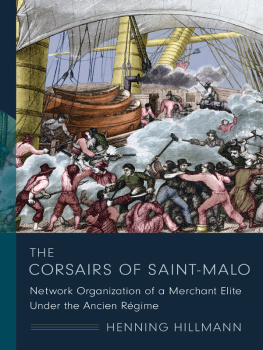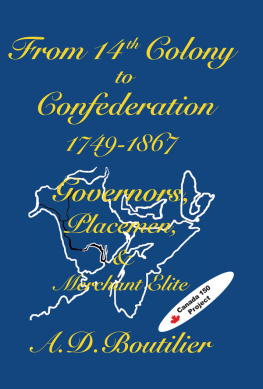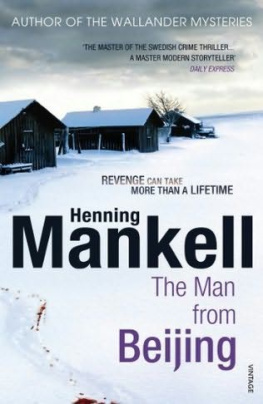Table of Contents
THE CORSAIRS
OF SAINT-MALO
..........................
THE MIDDLE RANGE
THE MIDDLE RANGE
...................................
Edited by Peter S. Bearman and Shamus R. Khan
The Middle Range, coined and represented by Columbia sociologist Robert Merton, is a style of work that treats theory and observation as a single endeavor. This approach has yielded the most significant advances in the social sciences over the last half century; it is a defining feature of Columbias department. This book series seeks to capitalize on the impact of approaches of the middle range and to solidify the association between Columbia University and its Press.
The Conversational Firm: Rethinking Bureaucracy in the Age of Social Media, Catherine J. Turco
Working for Respect: Community and Conflict at Walmart,
Adam Reich and Peter Bearman
Judge Thy Neighbor: Denunciations in the Spanish Inquisition,
Romanov Russia, and Nazi Germany, Patrick Bergemann
Concepts and Categories: Foundations for Sociological and Cultural Analysis, Michael T. Hannan, Gal Le Mens, Greta Hsu, Balzs Kovcs, Giacomo Negro, Lszl Plos, Elizabeth Pontikes, and Amanda J. Sharkey
THE CORSAIRS
OF SAINT-MALO
Network Organization
of a Merchant Elite
Under the Ancien Rgime
HENNING HILLMANN
Columbia University Press
New York
Columbia University Press
Publishers Since 1893
New York Chichester, West Sussex
cup.columbia.edu
Copyright 2021 Columbia University Press
All rights reserved
E-ISBN 978-0-231-54266-1
Library of Congress Cataloging-in-Publication Data
Names: Hillmann, Henning, author.
Title: The corsairs of Saint-Malo: network organization of a merchant elite under the
Ancien Regime / Henning Hillmann.
Description: New York: Columbia University Press, [2021] | Includes bibliographical
references and index.
Identifiers: LCCN 2020028804 (print) | LCCN 2020028805 (ebook) |
ISBN 9780231180382 (hardback) | ISBN 9780231180399 (trade paperback) |
ISBN 9780231542661 (ebook)
Subjects: LCSH: MerchantsFranceSaint-Malo. | PrivateeringFranceSaint-Malo.
| HarborsFranceSaint-Malo. | Saint-Malo (France)Commerce. | FranceForeign
economic relations. | FranceEconomic conditions17th century. | FranceEconomic
conditions18th century.
Classification: LCC HF3560.S3 H55 2021 (print) | LCC HF3560.S3 (ebook) |
DDC 381/.1094415dc23
LC record available at https://lccn.loc.gov/2020028804
LC ebook record available at https://lccn.loc.gov/2020028805
A Columbia University Press E-book.
CUP would be pleased to hear about your reading experience with this e-book at .
Cover design: Lisa Hamm
Cover image: Ambroise Louis Garneray, Capture of the prize ship Triton by the French corsair
Le Hasard. Archives dpartementales dIlle-et-Vilaine, 4Fg63.
Wikimedia Commons/Public domain.
Enferms le soir sous la mme clef dans leur cit, les
Malouins ne composaient quune famille.
Franois-Ren de Chateaubriand, Mmoires dOutre-Tombe
(vol. I, book 1, chap. 4)
CONTENTS
...................
I t seems only fitting that this book on organizational networks has spawned its own network of colleagues and friends to whom I am deeply indebted for their support throughout this long book project. It all began a long time ago while I was working on an article on the overseas investments of English merchants in the seventeenth century. A group of investors in the data I had set aside, perhaps for some follow-up study, were engaged in privateering enterprise. One day, my wife, Christina, rather innocently inquired who these privateers were. My routine response to this question was: they were somewhat like pirates. Any mentioning of pirates usually piques the interest of peoplewell, until I would add the much duller detail that privateers were different because they were sanctioned by a state, and that there was an entire legal apparatus in place that regulated their actions. Christina is of course a very smart economist and has a fine instinct for interesting research questions. So, we ended up writing an article together on English privateering enterprise as an economic opportunity. My ambitions grew once I stumbled upon some rather detailed historical data on the corsairs of Saint-Malo in France. The initial plan was to write a comparative economic history of privateering enterprise in France and Britain. Yet, once I had immersed myself in the archival holdings in Brittany, I realized that these sources were so rich that the corsairs and the networks they had created deserved a full book of their own. The rest is indeed history.
The project first took shape while I was a freshly minted assistant professor at Stanford. In our joint workshop on political mobilization, my senior colleagues Susan Olzak, Doug McAdam, and Andrew Walder were among those who offered encouragement and suggestions for my very first ideas. The Scancor seminar series, then chaired by Woody Powell, and the Social Science History workshop, directed by Gavin Wright and Avner Greif, both offered helpful venues to receive comments as the initial empirical findings were forthcoming. At this early stage, Guillaume Daudin shared his intimate knowledge of French colonial trade and steered me to a number of valuable sources. More than anybody at Stanford, I am deeply grateful to Becky Sandefur, Monica McDermott, and Dan McFarland for their friendship and for listening to my half-baked ideas about privateering networks. Few research projects are accomplished without the dutiful help of student research assistants, and the work behind this book is no exception. Hence, this finally is my opportunity to thank Jackelyn Hwang, Laure Ngiar, Andrew Parker, Diana Peng, James Greenberg, Warner Henson, and Denis Trapido, all of whom have long moved on to academic and professional careers of their own, for all their extraordinary contributions. This is also the place to express my gratefulness for the financial support of this research project by the National Science Foundation (grant number SES-0550848) and the Stanford Office of Technology Licensing Research Incentive Fund.
As I moved on to a new position at the University of Mannheim in Germany, the project did, of course, travel with me. It was in Mannheim that something resembling a book manuscript began to emerge. Here again, I could always rely on first-class student research assistants: Kristina Zapp, Nina Vallen, Pascale Mller, Jonas Richter, Bjrn Seitz, Jan Grau, Michel Maier-Bode, and Benjamin Rohr all went way beyond the proverbial call of duty. Three graduate students, in particular, were pivotal for the often-complex data analysis that went into the chapters that follow: Timo Bhm kept all taxation and partnership data in tight order and patiently translated many of my abstract technical ideas into tangible R-code. Pavel Dimitrovs programming skills proved to be invaluable throughout. Katharina Burgdorf did much of the same for the sequence analysis that underpins the study of merchant careers in . Little of this book would have been accomplished without them. I also wish to thank the Mannheim Center for European Social Research for its administrative and financial support.















